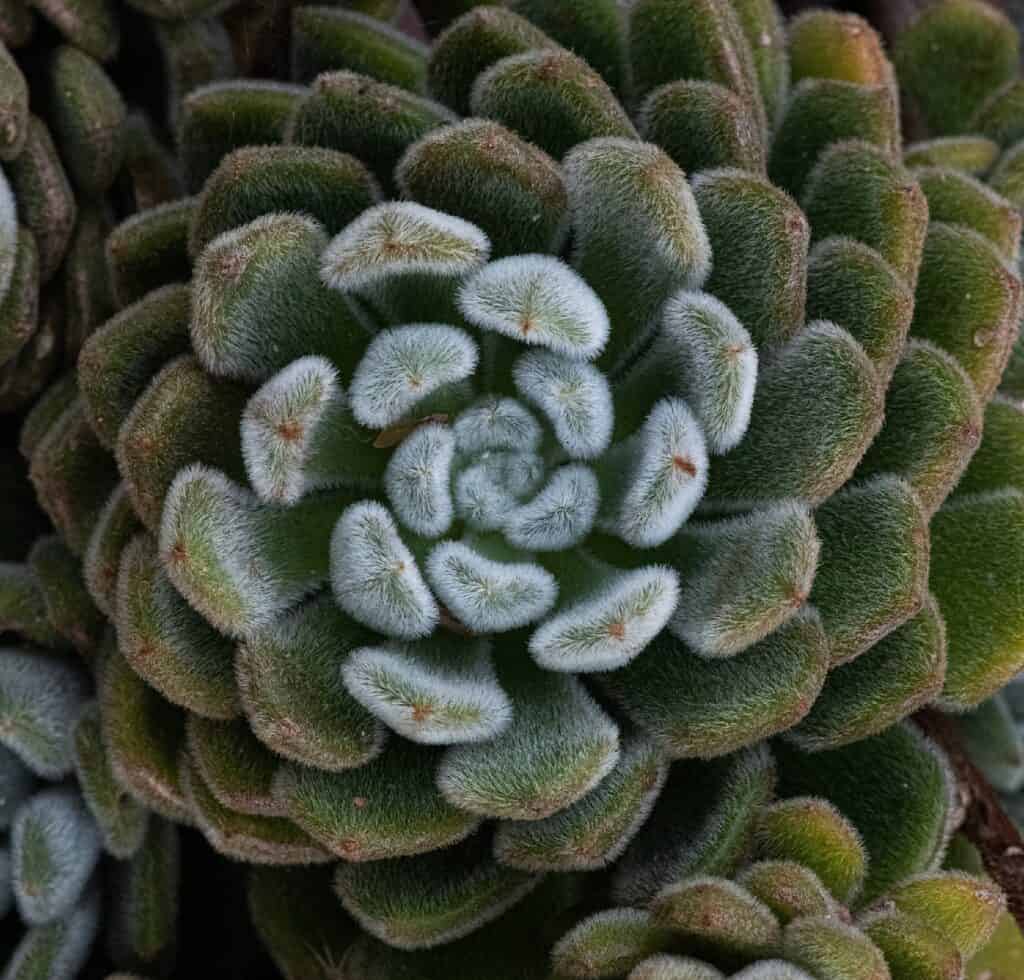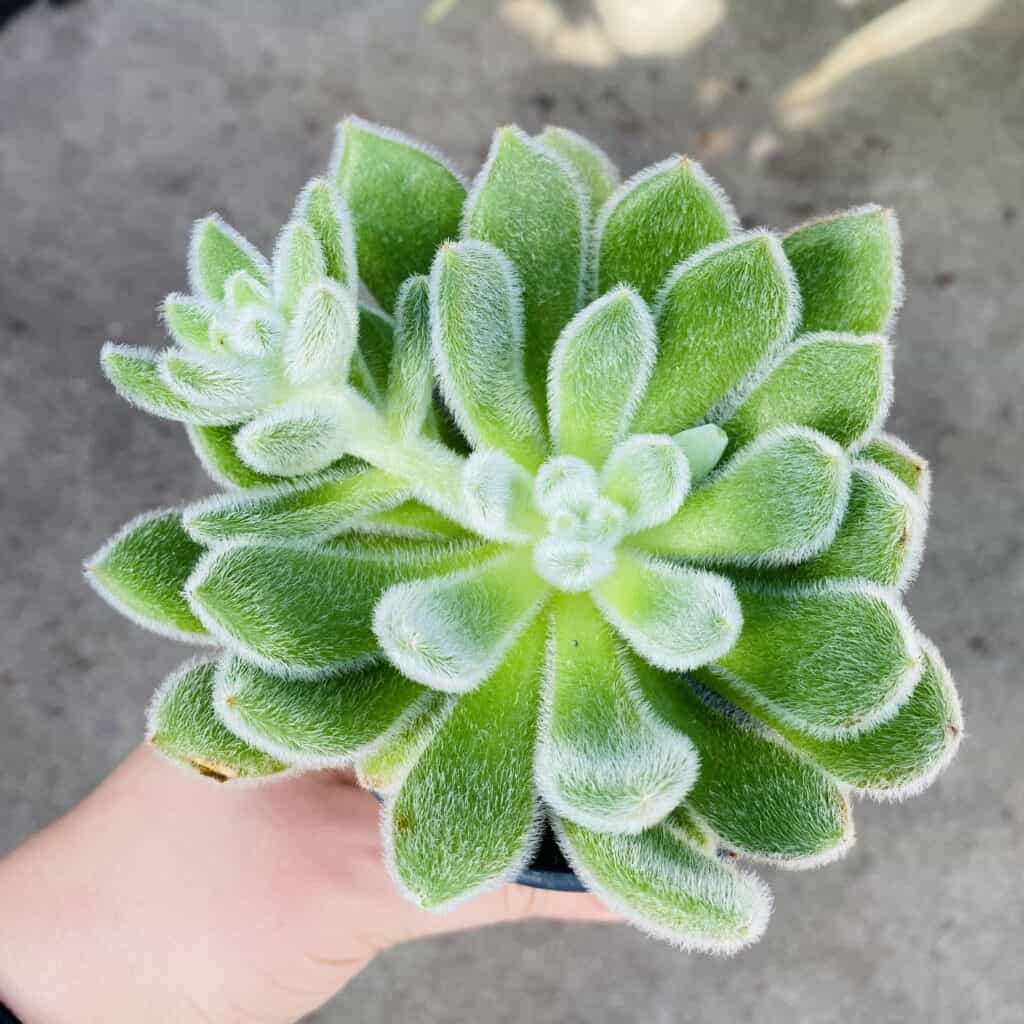Echeveria Setosa ‘Mexican Firecracker’ – Info & Care Guide
I absolutely love shopping online for succulents and gardening supplies. If you aren't already saving money by comparing prices online, give it a try! Here are six of my favorite things that I have purchased online as I build my own succulent oasis:
I recently became fascinated with the cozy world of fuzzy succulents and have been hooked ever since. Whenever I visit my local garden centers, I find myself drawn to these unique plants with their soft, velvety texture. It’s always difficult to resist the temptation of adding another echeveria to my collection.
One type of succulent I’ve grown particularly fond of is Echeveria Setosa, also known as the firecracker plant. This Mexican native produces large rosettes of green leaves with fuzzy hairs and a prominent pointy tip. It’s a stunning species that adds an interesting touch to any garden or home decor.
Due to its low-maintenance nature, the Echeveria Setosa is perfect for those of us who need some greenery in our lives but don’t always have the time (or energy) to devote to complex care routines. While the care for various succulent types may be similar, it’s crucial to understand the specific differences for each plant. With that in mind, let’s dive into what makes Echeveria Setosa special and how you can provide the best care for your new plant friend!
Scientific Name
Echeveria Setosa ‘Mexican Firecracker’
Common Name
Firecracker Echeveria, Firecracker Plant
Physical Description of Echeveria Setosa

Whether you’re a succulent enthusiast or just starting out, the Echeveria Setosa is a must-have for any collection. This flashy succulent is known for its remarkable texture and beautiful, lime-green coloring. Its dense, branching stems are topped with rosettes of spoon-shaped, fleshy leaves that are covered in fine, white hairs.
Mature rosettes can reach up to 12 inches wide and as it grows, the Echeveria Setosa will spread out in beautiful mats of offsets. During late spring or early summer, you will be treated to clusters of vibrant orange-red flowers with yellow tips that will add an entirely different level of color and beauty to your succulent collection.
Related: Echeveria ‘Doris Taylor’ – Information & Complete Care Guide
Growing Season of Echeveria Setosa
The Echeveria Setosa is an ideal succulent for those living in warmer climates. It loves the sun and prefers temperatures above 40 to 50 degrees Fahrenheit and will go dormant in colder temperatures.
The ‘Mexican Firecracker’ can be grown indoors if you provide it with plenty of sunlight and keep it warm, but during the late spring and summertime, you should move it outdoors to allow it to thrive. That’s when this plant will show its best colors, so make sure not to miss it!
This succulent is truly a sight to behold in the warm summer months with its vibrant blooms and lush foliage. Just make sure that you bring your succulent back indoors as soon as the temperatures start to drop and the nights get cold.
How to Care for Echeveria Setosa
Caring for your Echeveria Setosa can be made simple with these tips. For more information, I have provided links to my detailed guides.
Watering Needs of Echeveria Setosa
Watering your Echeveria Setosa succulent is a delicate balance—too much and you will end up with root rot, not enough and the plant will start to look wilted and stressed.
During its growing season, this succulent should be watered every 1 to 2 weeks. Make sure to give the soil a complete soaking and then allow it to drain and dry out completely before watering it again.
Once the weather starts to cool off, you can reduce watering down to once every one to two months, depending on conditions. In its dormant winter season, the ‘Mexican Firecracker’ will rarely need to be watered at all.
Related: How to Start a Greenhouse for Succulents
Sunlight Needs of Echeveria Setosa
The Echeveria Setosa loves plenty of sunlight. In its ideal climate, this succulent should be placed in a spot that gets at least six hours of direct sunlight each day. If the temperature gets too hot, you might need to move your plant into a slightly shadier spot or provide some extra protection, such as a canopy.
If you are growing your Firecracker Echeveria indoors, make sure to place it in a room that gets plenty of bright light and rotate the pot occasionally so all sides receive some sunlight. Supplement natural light with succulent grow lights for a few hours each day if your plant is not getting enough from its environment.
Soil Needs of Echeveria Setosa
The Echeveria Setosa needs well-draining soil to thrive. Luckily, you can make your own soil mix at home with a few simple ingredients.
Start by combining coarse sand, potting soil, and perlite or pumice. You can even add some small pebbles or horticultural charcoal to the mix for extra drainage. The Firecracker Plant benefits from a bit of organic matter, so adding a scoop of compost or worm castings is a good way to provide some additional nutrients.
Once you’ve mixed your soil, make sure to test it before you plant your Echeveria Setosa. Fill a pot with your soil mix, soak it with water, and let it sit overnight. If the soil has drained properly, you’re all set. If there’s any water left in the bottom of the pot, you’ll need to adjust your soil mix before planting your succulent.
In addition to having well-draining soil, choosing a pot with good drainage will also help your succulent avoid root rot and other effects of overwatering. Terracotta pots are my favorite, as they allow water to evaporate quickly.
Related: Best Succulents for Full Sun
Propagation Methods of Echeveria Setosa

The Echeveria Setosa can easily be propagated by stem or leaf cuttings, and by offsets.
To propagate with a stem cutting, snip off a healthy stem and allow it to callous over for a couple of days before planting. You can also propagate in the same way using a leaf – just snap off one of the leaves near the base of the plant and allow it to callous over before planting.
Once your cutting has fully calloused, fill a pot with well-draining soil and nestle in your cutting. You can water lightly, but make sure that the soil is allowed to dry out between watering sessions. With proper care, you should see roots developing within one to two weeks.
A content Echeveria Setosa should also produce quite a few offshoots, so you’ll soon have more cuttings for propagation. Just remember to be gentle when removing the offsets – tugging too hard could damage both them and the mother plant.
Related: Black Succulents
Troubleshooting Echeveria Setosa
If your Echeveria Setosa starts to look unhealthy, there are a few common problems that you may need to troubleshoot to get your succulent back to tip-top shape.
Common Signs of Overwatering
If you notice that your Echeveria Setosa is looking sad, it might be due to overwatering. Some common warning signs of overwatering include wilting or yellowed leaves, brown spots on the foliage, and root rot. To ensure proper hydration levels for your succulent, wait until its soil has dried out completely before watering again.
Common Signs of Lack of Sunlight
The Echeveria Setosa loves plenty of sunlight and can become stressed or even die if it doesn’t get enough. If you house your succulent indoors and notice that the leaves are turning pale, or that the growth is stunted, it could be a sign that your plant needs more light.
Make sure to place your succulent in a bright spot indoors and rotate the pot occasionally for even lighting exposure. If you cannot provide at least six hours of sunlight, and the plant is stretching toward the sun, consider adding a grow light to supplement.
Related: How to Treat, Heal, and Avoid Succulent Sunburn
Common Signs of Mealybugs & Pests
Mealybugs and other pests can quickly infest your Echeveria Setosa if left unchecked. If you notice small, white, cottony spots on the foliage, your succulent has likely been invaded by mealybugs. To get rid of them, use a cotton swab dipped in rubbing alcohol to wipe away all of the visible pests and eggs. You can also spray your plant with neem oil to prevent future infestations.
Echeveria Setosa in Review
From its bright and quirky foliage to its easy propagation methods, the Echeveria Setosa is an ideal choice for succulent enthusiasts of all levels. By providing it with proper care and attention, your succulent should remain healthy and vibrant for years to come.
Whether you’re a beginner or an experienced grower, following these simple tips will ensure that your Echeveria Setosa thrives in your home. It takes patience and dedication to enjoy the beauty of this unique succulent for many seasons.
Related: Fast-Growing Succulents for Lush Windowsills and Gardens
